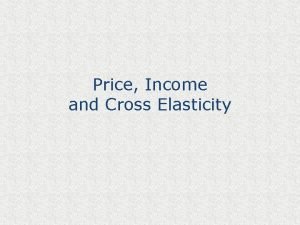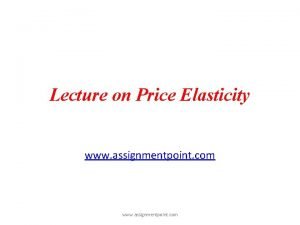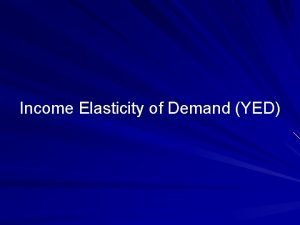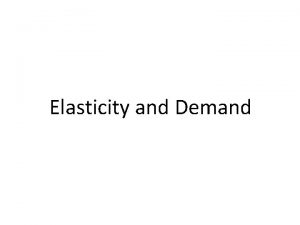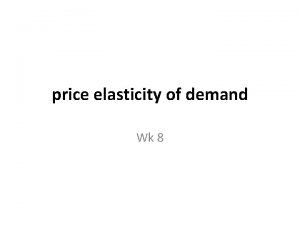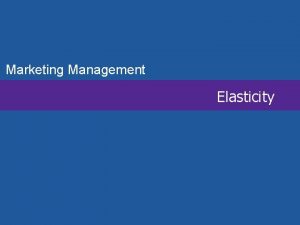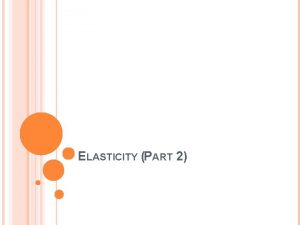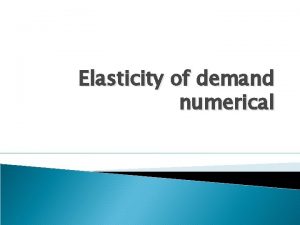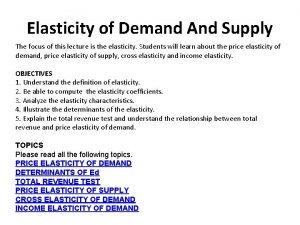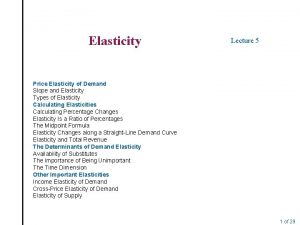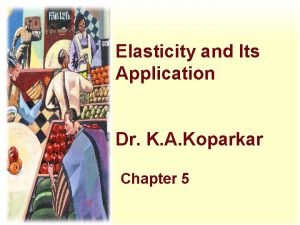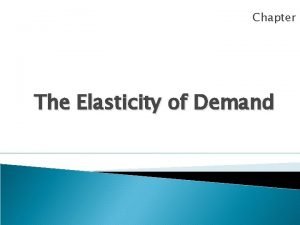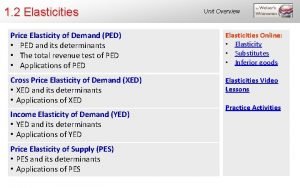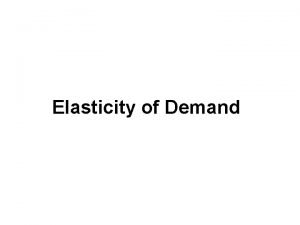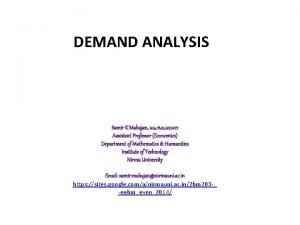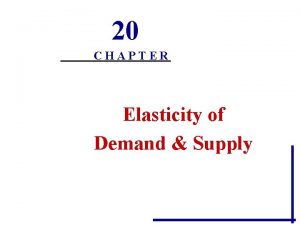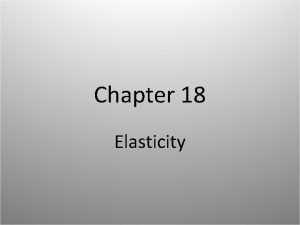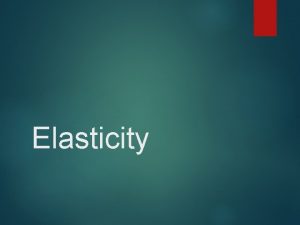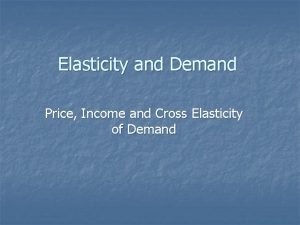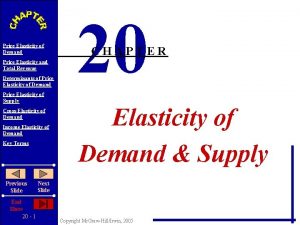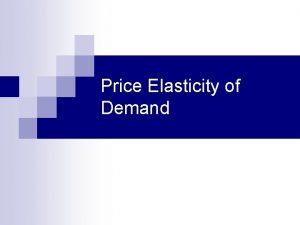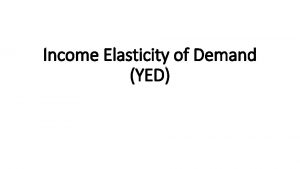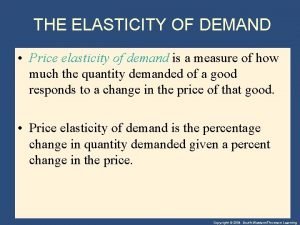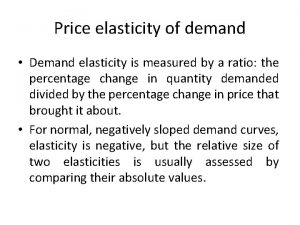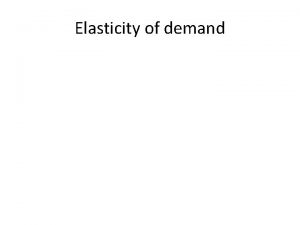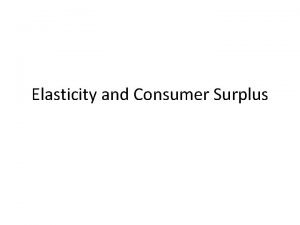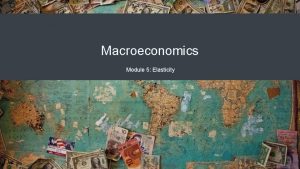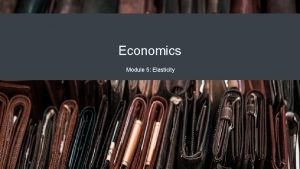Price and Income Elasticity Estimates of Cigarette Demand

















- Slides: 17

Price and Income Elasticity Estimates of Cigarette Demand in Bosnia and Herzegovina using two-part model Tobacco Taxation team Bosnia and Herzegovina: Anđela Pepić, Dragan Gligorić, Ljubiša Mićić, Borislav Vukojevic and Dragana Preradović ECTo. H, 19 -22 February 2020, Berlin

Bosnia and Herzegovina • Region – SE Europe • Income Group: Upper middle • GDP per capita: 6, 065 $ in 2018 • Population 3, 32 millions • Capital city: Sarajevo • Unemployment rate: 15, 7 (2019) • Average wage in 2019: 470 EUR

Introduction • Even though there has been a steady decline in smoking prevalence in Bosnia and Herzegovina (B&H), smoking remains a significant health risk in the country. • Cigarette taxation in B&H consists of two cigarette excises (specific tax and ad valorem tax) and the valueadded tax. • Since prices of tobacco products in the EU are considerably higher than the prices in B&H, there is a space for excise tax and price increases. 3

Tobacco taxation in B&H YEAR 2010 Weighted Average Price (pack of 20) (in 1. 06 EUR) 2011 2012 2013 2014 2015 2016 2017 2018 1. 27 1. 45 1. 64 1. 79 1. 98 2. 14 2. 32 2. 53 VAT (14, 52% of price) 0. 15 0. 18 0. 21 0. 24 0. 26 0. 29 0. 31 0. 34 0. 37 Ad valorem excise (42% of price) 0. 45 0. 53 0. 61 0. 69 0. 75 0. 83 0. 90 0. 98 1. 06 Specific excise (value) 0. 15 0. 23 0. 31 0. 38 0. 46 0. 54 0. 61 0. 69 0. 77 1. 67 1. 83 71. 69% 72. 32% 2. 00 2. 20 86. 22% 86. 85% Total Excise Burden 0. 60 0. 76 0. 92 1. 07 1. 21 1. 37 1. 51 per pack (in EUR) Total Excise Burden per pack (as % of 56. 1% 60. 16% 63. 38% 65. 22% 67. 63% 69. 31% 70. 48% price) Total Excise and VAT Burden per pack (in 0. 75 0. 95 1. 13 1. 31 1. 47 1. 66 1. 82 EUR) Total Excise and VAT 70. 7% 74. 69% 77. 91% 79. 75% 82. 16% 83. 84% 85. 01% Burden (as % of price) 4

Tobacco consumption trends in B&H 100. 00% 83. 88 76. 52 57. 55 50. 00% 57. 45% 37 1. 58 100 BAM 80 BAM 60 BAM 48. 40% 32 2. 37 33. 80% 23 3. 65 0. 00% 40 BAM 2007 2011 2015 Average real household expenditure on cigarettes Prices (average real unit value in municipality) Smoking prevalence (% of households) Average number of cigarettes pack smoked (per household) *1 EUR = 1. 95583 BAM 5

Methodology • This analysis uses micro level data, obtained from HBS in B&H in 2007, 2011 and 2015. • The sample contains 21, 424 households, of which 9953 are smoking households • We use two part model that splits the cigarettes consumption in two-parts: – �� (�� | �� ) = Pr (�� > 0) × �� (�� |�� > 0) – Prevalence elasticity: The proportionate change in prevalence of smoking as a result of a given proportionate change in price of cigarettes – Conditional Elasticity: The proportionate change in the number of cigarettes smoked as a result of a given proportionate change in the price of cigarettes 6

Methodology • We estimate prevalence elasticity using logit model • We use two different methods to eastimate conditional elasticity: – – Deaton method (Deaton, 1988) and Generalized Linear Model (GLM). The Deaton model is the preferred method Results from the GLM model are used as a robustness check for conditional elasticity. 7

Methodology • We use different control variables in regession analysis: – household size (ln), – age and gender composition of the household, – mean and maximum level of education of the household members, – household type by economic activity (employed, selfemployed, pensioner and unemployed ). . . • We use different model specification (with variables in level and ln, without and with square term). . . and opt for best model according to the AIC, BIC and LL criteria. 8

Results • Prevalence elasticity VARIABLES Prevalence elasticity Price -0. 563*** (0. 051) Income 0. 374*** (0. 027) • Price and income elasticities are statistically significant and have expected signs. • The obtained elasticity shows that an increase in cigarettes prices by 1 percent leads to a decrease smoking prevalence by 0. 563 percent. • Higher household income by 1 percent increases the propensity to smoke by 0. 374 percent. 9

Results • Conditional demand elasticity using Deaton’s method Price Income Conditional elasticity -0. 458*** (0. 037) 0. 426*** (0. 017) • If cigarette prices in B&H increased by 10 percent, the quantity demanded for cigarettes would decrease by 4. 6 percent. • If income increases by 10 percent, the quantity of cigarettes demanded would increase by 4. 3 percent 10

Results • Conditional demand elasticity using GLM method VARIABLES Price Income Conditional elasticity -0. 567*** (0. 046) 0. 413*** (0. 019) • If cigarette prices in B&H increased by 10 percent, the quantity demanded for cigarettes would decrease by 5. 7 percent. • If income increases by 10 percent, the quantity of cigarettes demanded would increase by 4. 1 percent 11

Results • Total price and income demand elasticity Elasticity Prevalence Elasticity Price Income Conditional Elasticity Total demand elasticity Logit model and Deaton method -0. 563*** (0. 051) 0. 374*** (0. 027) -0. 458*** (0. 037) 0. 426*** (0. 017) -1. 018 0. 802 • If cigarette prices in B&H increased by 10 percent, the quantity demanded for cigarettes would decrease by 10. 2 percent. • If income increases by 10 percent, the quantity of cigarettes 12 demanded would increase by 8 percent.

Results and implications – About 55 percent of this effect is due to a reduction in prevalence, and around 45 percent from a decrease in quantity of cigarettes consumed by those who smoke. – Having in mind that price is a significant factor in tobacco control, higher prices resulting from an excise tax increase would reduce total consumption as well as discourage initiation of smoking. 13

Impact of a specific excise increase on consumption and government revenue • Increasing the specific excise tax by 10 percent or 25 percent would reduce cigarette consumption and at the same time, increase government revenue. Scenario Effect on overall Effect on total quantity of cigarette government revenue consumption (percent) 10 % 4. 85 2. 79 25 % 15 1. 46 50 % 33. 24 6. 44 • However, this simulation does not take into account the savings in 14 health care expenditures for tobacco-related illnesses.

Key messages (1) • A 25 percent excise tax increase (from 38. 3 EUR / 1000 sticks to 47. 93 EUR / 1000 sticks) resulting in price increase from 2. 53 EUR to 2. 97 EUR (17. 43% increase) would reduce consumption by 15. 5 percent, and government revenue would still increase by 1. 46 percent. • The benefits of increasing the specific excise tax are higher both for society and government revenue (in terms of reducing the costs of health care due to lower consumption of cigarettes). • Thus, tobacco taxation policy should include a much larger increase in specific excise tax than current excise tax calendar. 15

Key messages (2) • Increases in income lead to higher tobacco consumption as it makes tobacco more affordable. • Having in mind that there is a trend of salary increase in B&H, tax policy should be adequately designed to significantly increase the excise taxes and, through it, prices, to more than offset the impact of higher income on consumption of tobacco. 16

Thank you for your attention! For any further inquires contact Dragan Gligorić Faculty of Economics University of Banja Luka dragan. gligoric@ef. unibl. org Anđela Pepić Entrepreneurship and Technology Transfer Centre University of Banja Luka andjela. pepic@unibl. org Disclaimer: University of Banja Luka, Entrepreneurship and Technology Trasnfer Center (ETTC UNIBL) is working in cooperation with the Institute of Economic Sciences from Belgrade, which is coordinating a regional network of researchers in Southeastern Europe on tobacco taxation. The project is funded by the University of Illinois at Chicago’s (UIC) Institute for Health Research and Policy to conduct economic research on tobacco taxation in Bosnia and Herzegovina. UIC is a partner of the Bloomberg Initiative to Reduce Tobacco Use. The views expressed in this document cannot be attributed to, nor do they represent, the views of UIC, the Institute for Health Research and Policy, or Bloomberg Philanthropies. 17
 Price and income elasticity
Price and income elasticity Income elasticity of demand formula
Income elasticity of demand formula Yedyed
Yedyed Income elasticity of demand
Income elasticity of demand Cross price elasticity formula
Cross price elasticity formula Formula for price elasticity of demand
Formula for price elasticity of demand What are the 5 determinants of price elasticity of demand
What are the 5 determinants of price elasticity of demand Total expenditure method
Total expenditure method Demand analysis example
Demand analysis example Elasticity table
Elasticity table Midpoint formula economics
Midpoint formula economics Midpoint formula economics
Midpoint formula economics Elasticity of supply
Elasticity of supply Total outlay method formula
Total outlay method formula Cross-price elasticity of demand formula
Cross-price elasticity of demand formula Promotional elasticity of demand
Promotional elasticity of demand Perfectly inelastic demand
Perfectly inelastic demand Price elasticity of demand
Price elasticity of demand
